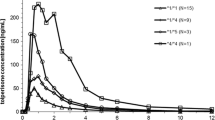Abstract
Purpose
The aim of the present study was to evaluate the effect of the herbal drug Rhodiola rosea on the activity of the cytochrome P-450 (CYP) enzymes CYP1A2, CYP2C9, CYP2C19, CYP2D6, and CYP3A4 in humans.
Methods
In a randomized cross-over study, 13 healthy volunteers were given a cocktail with single doses of the CYP substrates caffeine (CYP1A2), losartan (CYP2C9), omeprazole (CYP2C19), dextromethorphan (CYP2D6), and midazolam (CYP3A4) with and without 14 days of pretreatment with a commercially available R. rosea product (Arctic Root, produced by the Swedish Herbal Institute). Four hours after intake of the drug cocktail, a blood sample was obtained, the serum concentrations of the drugs and their metabolites were analyzed, and the metabolic ratios were calculated as a measure of CYP enzyme activity.
Results
A statistically significant 21 % decrease in the EXP-3174/losartan ratio was found after pretreatment with R. rosea (p = 0.023), indicating a reduced CYP2C9 metabolic activity. The effect was more pronounced in CYP2C9 extensive metabolizers than in CYP2C9 intermediate and poor metabolizers. For the other CYP enzymes tested, no significant effects were observed.
Conclusions
This study indicates that R. rosea inhibits the metabolic capacity of CYP2C9 in humans. Although the effect is modest, it might be clinically relevant during treatment with CYP2C9 substrates with a narrow therapeutic index, such as phenytoin and warfarin.

Similar content being viewed by others
References
Panossian A, Wikman G, Sarris J (2010) Rosenroot (Rhodiola rosea): traditional use, chemical composition, pharmacology and clinical efficacy. Phytomedicine 17(7):481–493. doi:10.1016/j.phymed.2010.02.002
Blomkvist J, Taube A, Larhammar D (2009) Perspective on roseroot (Rhodiola rosea) studies. Planta Med 75(11):1187–1190. doi:10.1055/s-0029-1185720
Hellum BH, Tosse A, Hoybakk K, Thomsen M, Rohloff J, Georg Nilsen OG (2010) Potent in vitro inhibition of CYP3A4 and P-glycoprotein by Rhodiola rosea. Planta Med 76(4):331–338. doi:10.1055/s-0029-1186153
Panossian A, Hovhannisyan A, Abrahamyan H, Gabrielyan E, Wikman G (2009) Pharmacokinetic and pharmacodynamic study of interaction of Rhodiola rosea SHR-5 extract with warfarin and theophylline in rats. Phytother Res 23(3):351–357. doi:10.1002/ptr.2631
Spanakis M, Vizirianakis IS, Batzias G, Niopas I (2013) Pharmacokinetic interaction between losartan and Rhodiola rosea in rabbits. Pharmacology 91(1–2):112–116. doi:10.1159/000345929
Ryu JY, Song IS, Sunwoo YE, Shon JH, Liu KH, Cha IJ, Shin JG (2007) Development of the “Inje cocktail” for high-throughput evaluation of five human cytochrome P450 isoforms in vivo. Clin Pharmacol Ther 82(5):531–540. doi:10.1038/sj.clpt.6100187
US Food and Drug Administration (2001) Guidance for industry: bioanalytrical method validation. http://www.fda.gov/downloads/Drugs/…/Guidances/ucm070107.pdf. Accessed March 2013
Soldner A, Benet LZ, Mutschler E, Christians U (2000) Active transport of the angiotensin-II antagonist losartan and its main metabolite EXP 3174 across MDCK-MDR1 and caco-2 cell monolayers. Br J Pharmacol 129(6):1235–1243. doi:10.1038/sj.bjp.0703150
Choi JS, Choi JS, Choi DH (2013) Effects of licochalcon A on the pharmacokinetics of losartan and its active metabolite, EXP-3174, in rats. Pharmazie 68(11):882–888
Lo MW, Goldberg MR, McCrea JB, Lu H, Furtek CI, Bjornsson TD (1995) Pharmacokinetics of losartan, an angiotensin II receptor antagonist, and its active metabolite EXP3174 in humans. Clin Pharmacol Ther 58(6):641–649. doi:10.1016/0009-9236(95)90020-9
Yasar U, Forslund-Bergengren C, Tybring G, Dorado P, Llerena A, Sjoqvist F, Eliasson E, Dahl ML (2002) Pharmacokinetics of losartan and its metabolite E-3174 in relation to the CYP2C9 genotype. Clin Pharmacol Ther 71(1):89–98. doi:10.1067/mcp.2002.121216
Kaukonen KM, Olkkola KT, Neuvonen PJ (1998) Fluconazole but not itraconazole decreases the metabolism of losartan to E-3174. Eur J Clin Pharmacol 53(6):445–449
Ahmed A, Stephens JC, Kaus CA, Fay WP (2008) Impact of preemptive warfarin dose reduction on anticoagulation after initiation of trimethoprim-sulfamethoxazole or levofloxacin. J Thromb Thrombolysis 26(1):44–48. doi:10.1007/s11239-007-0164-z
Zhou H, Tong Z, McLeod JF (2004) “Cocktail” approaches and strategies in drug development: valuable tool or flawed science? J Clin Pharmacol 44(2):120–134. doi:10.1177/0091270003261333
Tanaka S, Uchida S, Inui N, Takeuchi K, Watanabe H, Namiki N (2014) Simultaneous LC-MS/MS analysis of the plasma concentrations of a cocktail of 5 cytochrome P450 substrate drugs and their metabolites. Biol Pharm Bull 37(1):18–25
An G, Mukker JK, Derendorf H, Frye RF (2015) Enzyme- and transporter-mediated beverage-drug interactions: an update on fruit juices and green tea. J Clin Pharmacol. doi:10.1002/jcph.563
Frary CD, Johnson RK, Wang MQ (2005) Food sources and intakes of caffeine in the diets of persons in the United States. J Am Diet Assoc 105(1):110–113. doi:10.1016/j.jada.2004.10.027
Author’s contribution
Ole Kristian Forstrønen Thu has participated in study design, recruited participants, gathered data, performed the statistical calculations, written the primary draft of the manuscript, created tables and figures, and revised and approved the manuscript.
Olav Spigset has been primary responsible for study design, taken part in the data analysis, written some sections of the manuscript, and reviewed critically and approved the manuscript.
Odd Georg Nilsen has been involved in study design, supervision of participants during test days, and reviewed critically and approved the manuscript.
Bent Hellum has supervised the study, performed data analysis, method validation, and reviewed critically and approved the manuscript.
Author information
Authors and Affiliations
Corresponding author
Ethics declarations
All procedures performed were in accordance with the ethical standards of the institutional and regional research ethics committee and with the 1964 Helsinki Declaration and its later amendments or comparable ethical standards.
Conflict of interest
The authors declare that they have no competing interests.
Electronic supplementary material
Below is the link to the electronic supplementary material.
ESM 1
(DOCX 43 kb)
Rights and permissions
About this article
Cite this article
Thu, O.K., Spigset, O., Nilsen, O.G. et al. Effect of commercial Rhodiola rosea on CYP enzyme activity in humans. Eur J Clin Pharmacol 72, 295–300 (2016). https://doi.org/10.1007/s00228-015-1988-7
Received:
Accepted:
Published:
Issue Date:
DOI: https://doi.org/10.1007/s00228-015-1988-7




